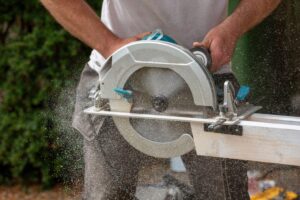Some UK construction sites have no effective design or planning to eliminate risks from dust and the hierarchy of controls is simply not considered at all, says the regulator.

CREDIT: Peter Titmuss/Alamy Stock Photo
A campaign by the Health and Safety Executive (HSE) has found some sites do not consider the use of pre-cut materials and put no control measures in place to minimise the risks, such as water suppression, on-tool extraction or the use of respiratory protective equipment (RPE).
As part of the Dust Kills Campaign more than 1,000 inspections were carried out between May and July to look at what was being done to prevent or control the risks from construction dust.
HSE’s Acting Head of Construction Division Mike Thomas said: “Regularly breathing in the dust generated by many construction activities can cause diseases like lung cancer, asthma, chronic obstructive pulmonary disease (COPD) and silicosis. Every year we see construction workers die from these diseases caused or made worse by their work because the necessary precautions required to protect their long-term lung health have not been taken by employers and workers themselves.
“The 1,000 plus inspections completed took place across a range of construction sites to check the action businesses are taking to ensure their workers’ health is being protected. Where planning around the risks of dust and controls to prevent exposure are not even considered, it shows there is still plenty of room for improvement.”
At some sites, inspectors found there was no on-tool extraction in place on high-powered cutting saws that generate silica and wood dust or poorly maintained extraction equipment such as hoses and units making it ineffective. There were instances of suitable RPE not being made available on site or sometimes it was available, but no one ensured it was used. On occasion, the health of workers was not being considered when sweeping up indoors, with no damping down to control the dust.
However, the inspectors also found good practices in how workers’ exposure to dust is being managed and controlled at some construction sites. Some sites made use of motorised water suppression alongside face fit-tested FFP3 RPE to reduce exposure to silicosis and lung cancer-causing respirable crystalline silica (RCS).
At some sites they found air-fed hoods – or powered air respirators – being used when working with high-powered cutting saws during carpentry, to prevent exposure to asthma-causing wood dust. And some sites found details of HSE’s campaign within company health, safety & environmental newsletters to raise awareness.
The HSE is now carrying out a full evaluation of the inspection data.
The regulator reminded employers that the law requires them to prevent the ill health of their workers as far as reasonably practicable, including prevention or adequate control of workers’ exposure to construction dust. They said ideally elimination of the risk of exposure to dust for workers should be achieved by good design and planning.
What makes us susceptible to burnout?
In this episode of the Safety & Health Podcast, ‘Burnout, stress and being human’, Heather Beach is joined by Stacy Thomson to discuss burnout, perfectionism and how to deal with burnout as an individual, as management and as an organisation.
We provide an insight on how to tackle burnout and why mental health is such a taboo subject, particularly in the workplace.


